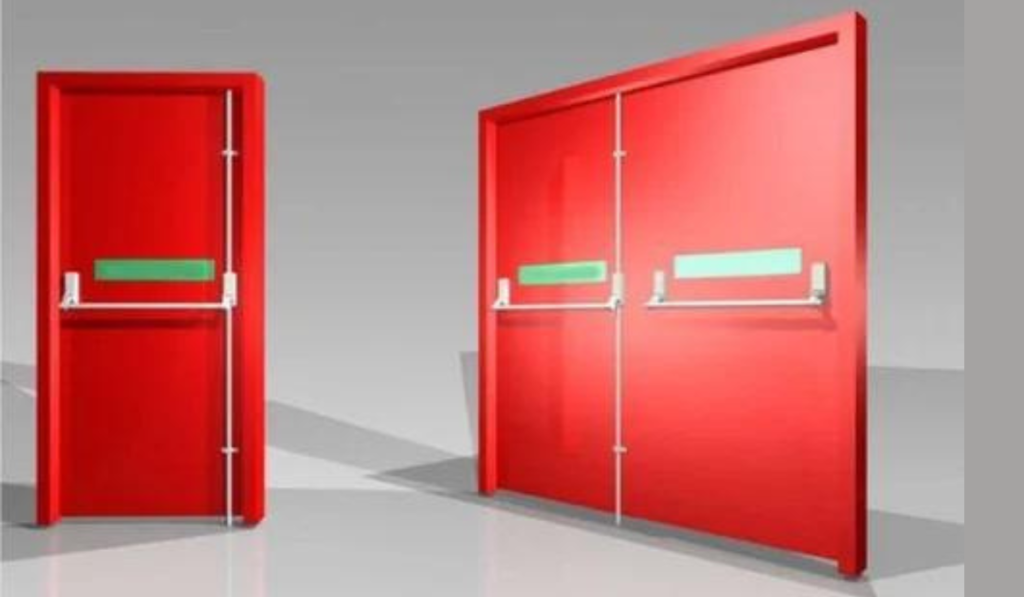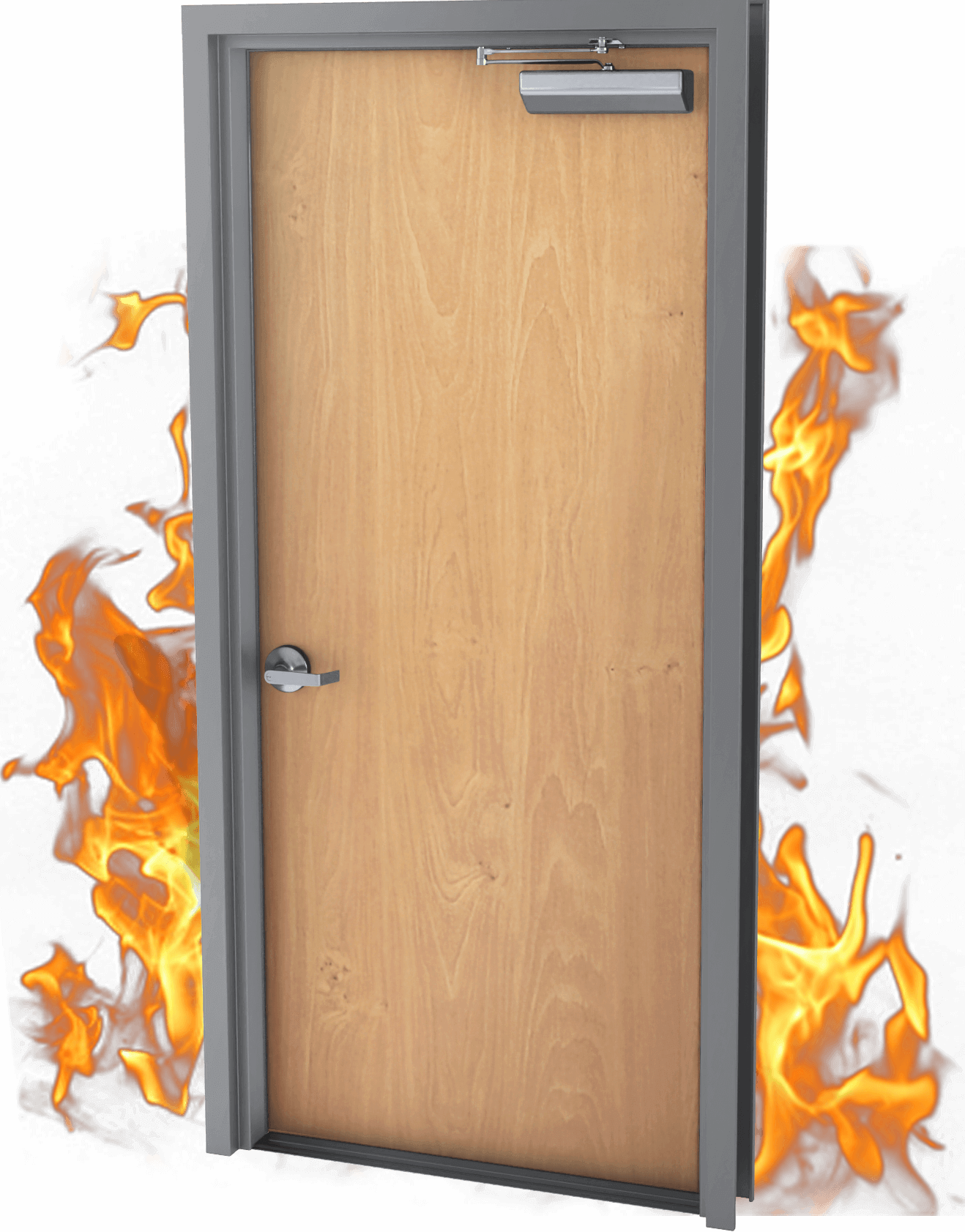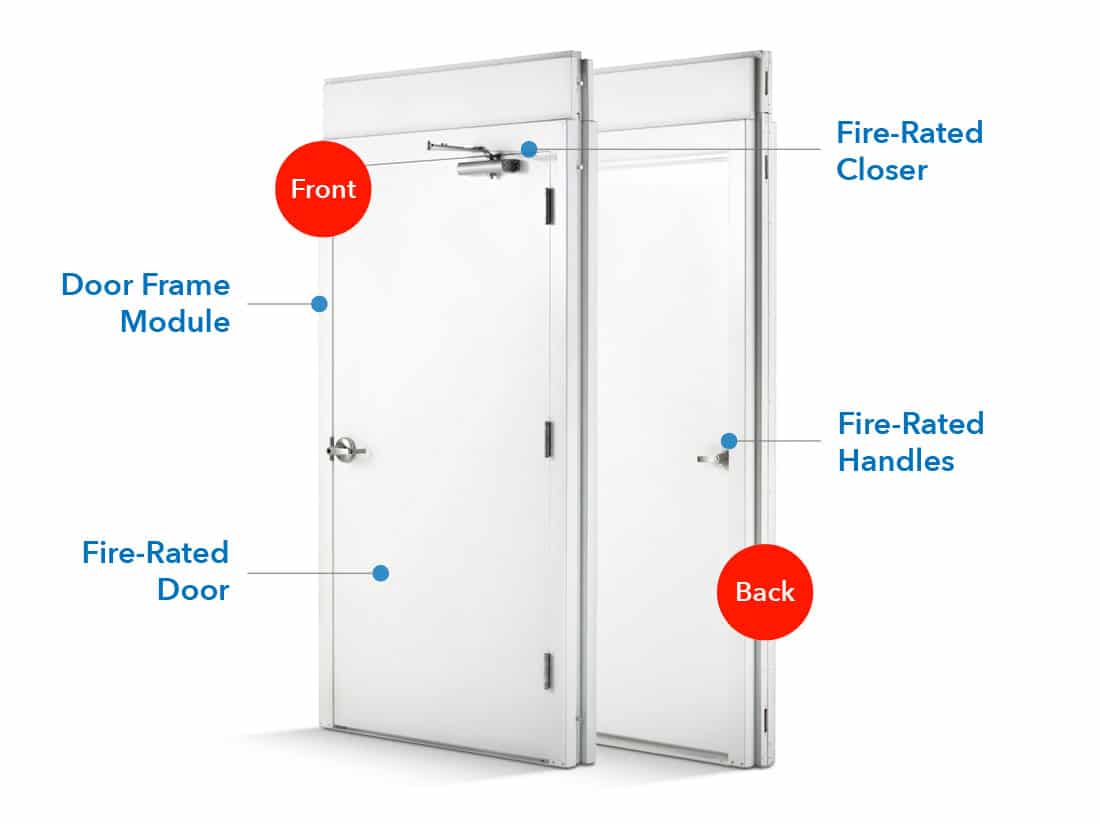A fire rated door is a protective barrier designed to resist the spread of fire and smoke. These doors are essential for compartmentalizing a building to ensure safety.
Fire rated doors are critical components in the infrastructure of commercial and residential buildings, playing a vital role in fire safety protocols. They are specifically constructed and tested to withstand fire for a certain period, typically ranging from 20 minutes to 3 hours, depending on the design.
The integration of these doors into a building’s architecture enhances the occupants’ protection and provides precious time for evacuation during an emergency. Compliance with safety standards and regulations is a key factor in the manufacturing and installation of these specialized doors. Proper maintenance and regular inspections ensure their optimal performance, making them a significant investment for any property owner concerned with safety and regulation adherence.

The Role Of Fire Rated Doors In Building Safety
The Role of Fire Rated Doors in Building Safety cannot be overstated. They serve as a critical component in a building’s design to safeguard lives and prevent the spread of fire and smoke. Let’s delve into their importance and how they function as part of a comprehensive fire containment and prevention strategy.
Fire Containment And Prevention Strategy
Fire rated doors are designed to be an integral part of fire containment and prevention within a building. These specialized doors resist the spread of flames and smoke for a specified period, usually ranging from 20 minutes to over 3 hours. This time allows occupants to evacuate safely and gives emergency services a window to enter and control the blaze, effectively reducing potential devastation.
- Compartmentalization: By segmenting different areas, fire rated doors prevent a fire from traveling throughout the building.
- Materials: Constructed with robust materials such as steel, gypsum, and glass that withstand extreme heat.
- Integrity: They maintain their structure during a fire, which is crucial for safety.
- Automatic closing: Many fire doors are equipped to close automatically in the event of a fire.
Safety Protocols And Building Codes
Strict adherence to safety protocols and building codes is essential for the installation and maintenance of fire rated doors. These codes provide guidelines that ensure doors are up to standards for effectively protecting against fires.
- Installation must follow precise guidelines to preserve the door’s fire rating.
- Regular inspections are mandated to ensure functionality and compliance.
- Repairs and upkeep of doors and hardware must adhere to specified safety codes.
Building codes vary by region but generally include requirements on door ratings, displaying proper signage, and ensuring unobstructed operation. These regulations are vital for creating a safe environment for all building occupants.
Anatomy Of A Fire Rated Door
Imagine a door that stands strong, even when faced with fire. That’s what a Fire Rated Door is all about. It’s built to shield and protect. Let’s peel back the layers and explore the anatomy of these safety barriers. Understanding their structure is key to appreciating their role in fire safety.
Core Materials: What Makes Them Resist Flames
The heart of a fire rated door is its core. This inner part must withstand high heat. Various materials serve this purpose. Each has its own flame-resisting property. Let’s look at some common core materials:
- Mineral Wool: It’s dense and slows down heat transfer.
- Gypsum: This material resists heat due to its water content.
- Steel: A metal that adds strength and fire resistance.
- VerMiculite: Combined with other substances, it expands when heated, adding protection.
These materials help doors to keep fire at bay for several hours.
Seals, Frames, And Hardware: Details That Matter
To function correctly, a fire door relies on more than just its core. Seals, frames, and hardware are the unsung heroes. Let’s break down their roles:
Seals:
- Intumescent seals expand with heat, sealing gaps to stop smoke and fire.
- Smoke seals prevent the passage of smoke around the door.
Frames:
Frames must match the door’s fire rating. They often comprise fire-resistant materials. Proper installation is crucial. The incorrect fitting can compromise the door’s integrity.
Hardware:
- Hinges must be heat-resistant and strong enough to hold the door.
- Locks and latches should secure the door but allow easy exit during emergencies.
- Closers ensure the door shuts automatically and stays closed.
These details work together with the core to protect lives and property. Even the smallest component plays a vital part in the door’s performance during a fire.
Classification And Ratings Explained
Fire-rated doors are essential safety features in buildings. They prevent the spread of fire and smoke between compartments. The classification and ratings of these doors determine where they’re used. Each rating signals a specific duration for which a door can withstand fire. Understanding these details is crucial for safety compliance and effective fire protection.
Understanding The Time-based Ratings
Time-based ratings on fire doors indicate how long they can resist fire. These measures are in minutes. They show the minimum amount of time a door can hold back fire under test conditions. There are common time-based ratings:
- 20-minute: Light protection, suitable for residential areas.
- 45-minute: Used in commercial and light industrial areas.
- 60-minute: Found in multiple dwelling or mixed-use buildings.
- 90-minute: Required for buildings like hospitals or schools.
- 180-minute: For high-risk areas such as archives or server rooms.
Deciphering The Labeling System
A fire-rated door’s label is its identity. It provides vital information on performance against fire. The labeling system is a mix of letters and numbers. They tell us the door’s capabilities. Here’s how to read it:
| Label Part | Meaning |
|---|---|
| Type | Door material and build |
| Rating | Time-based fire resistance |
| Temperature | Level of heat the door can withstand |
| Certification | Approval by testing authority |
For example, a label stating ‘B-60’ could mean ‘Type B construction’ with ’60-minute’ rating. This system helps you choose the right door for your space.

Credit: www.cdfdistributors.com
Installation Considerations For Optimal Performance
With the increasing emphasis on safety, fire rated doors are a critical component in safeguarding lives and property. These doors resist the spread of fire and smoke for a specified period, typically measured in hours. Proper installation is paramount to their performance. It ensures they function as designed in the event of a fire. A door that is not correctly installed could compromise the safety of a building’s occupants.
Professional Installation Vs. Diy
Deciding between professional installation and a do-it-yourself (DIY) approach requires careful consideration. Each option has its pros and cons.
- Professional Installation:
- Guarantees expertise and experience
- Ensures compliance with fire safety regulations
- Often includes a warranty
- DIY Installation:
- May reduce upfront costs
- Offers a personal sense of accomplishment
- Requires in-depth knowledge of fire door requirements
For the best results, consider a professional. They have the tools and know-how to ensure optimal performance.
Common Mistakes To Avoid During Installation
Even small errors can significantly affect a fire rated door’s functionality. Below are some common installation mistakes to avoid:
- Ignoring Manufacturer’s Installation Instructions
- Using Incompatible Components Not Rated for Fire
- Improper Gapping Around the Door Perimeter
- Failing to Secure the Door to the Wall Frame Properly
- Omitting Intumescent Seals or Incorrect Seal Placement
Attention to detail is crucial. Ensure all components suit the specific fire door rating. Check and double-check all aspects of installation against the manufacturer’s guidelines.
Regular Maintenance And Inspection: Ensuring Integrity
Regular maintenance and inspection are key in preserving the effectiveness of fire rated doors. These doors are an essential safety feature in buildings, designed to withstand fire and prevent spreading. Ensuring integrity depends on diligent care and scheduled checks.
Maintenance Checklist For Property Owners
Proper upkeep ensures fire rated doors function as intended. Follow this simple checklist:
- Check for damage: Look for signs of wear or damage to the door and its frame.
- Inspect seals: Ensure the intumescent seals are intact and have no breaks or gaps.
- Test self-closing mechanisms: Confirm doors close fully on their own.
- Clear obstructions: Keep the area around the door clear to ensure it can function without interference.
- Examine hardware: Verify hinges, locks, and handles are secure and in good condition.
Professional Inspection Schedules
Regular professional inspections determine the need for any repairs or replacements:
| Frequency | Action |
|---|---|
| Monthly | Visual inspection by property owner or staff |
| Semi-annually | Detailed check by a trained professional |
| Annually | Comprehensive inspection and certification |
A record of all inspections should be maintained to ensure compliance and safety.

Credit: en.lesso.com
Fire Rated Doors And Legal Compliance
When talking about safety in buildings, fire rated doors are critical. They provide vital protection in the event of a fire, slowing down the spread of flames and smoke. Ensuring these doors meet legal standards is not just good practice – it’s required by law. Properly installed and maintained fire rated doors can be the difference between safety and catastrophe.
Navigating Building Regulations And Standards
Building regulations detail the minimum requirements for fire safety. This includes the installation of fire rated doors. Different buildings might have different rules. It’s essential to know which apply to your project.
- Local building codes: Check with your municipality for specific requirements. They can vary from one place to another.
- International standards: Organizations like ASTM or the International Code Council provide widespread guidelines that can influence local codes.
Fire rated doors must have a specific fire-resistance rating. This is how long the door can withstand a fire. Most common ratings are 20, 45, 60, 90, and 180 minutes.
Certification And Compliance Documentation
Documentation proves that a fire rated door meets legal standards. Manufacturers should provide this with their products. Here’s what to look for in compliance documents:
| Certificate Type | Details |
|---|---|
| Label | Metal tag on door showing fire rating |
| Test reports | Results from fire resistance tests |
| Third-party certifications | Approval from independent testing agencies |
A quality fire rated door will come with all necessary compliance documentation. Make sure to keep these documents. They may be needed for future inspections.
Case Studies: Fire Rated Doors In Action
Fire rated doors are a crucial safety feature in buildings. They provide critical protection in the case of a fire. Witness real-life accounts where these doors have saved lives and property. Learn from past incidents to understand their importance better.
Saved By The Door: Real-life Incidents
- Office Building Blaze: In Atlanta, a fire broke out on the 14th floor of an office building. The fire rated doors held back flames for over an hour. This allowed everyone to escape safely.
- School Fire in Texas: When a fire started in a classroom, the closed fire rated door prevented it from spreading. Students evacuated from other parts of the school without any harm.
Lessons Learned From Fire-related Mishaps
Regular Inspection and Maintenance: A case study from New Jersey highlights this. A fire rated door failed due to poor maintenance, leading to significant damage.
Proper Usage: In a California hotel, a propped open fire rated door allowed smoke to spread to upper floors. This underlines the need for training on proper door usage.
Compliance with Codes: After a fire in a Chicago high-rise, investigators found non-compliant doors. These doors did not resist the fire as they should have. After this, the city enforced stricter code compliance.
The Future Of Fire Safety: Innovations In Fire Rated Doors
The subject of fire-rated doors is not just about preventing flames from spreading. It’s about evolving with technology to protect lives and property more effectively. Fire-rated doors are integral to this mission. They are pivotal in keeping blazes contained. But the future holds even more promise as we explore groundbreaking innovations in this field.
Technological Advancements And Smart Doors
In the realm of fire safety, technological strides have birthed smart doors. These are far from ordinary barriers. They are equipped with sensors and connectivity features. This allows for real-time alerts and automated responses in emergency situations. Key advances include:
- Automatic Seals: These activate upon detecting high temperatures, sealing off a room to halt the spread of fire.
- Integrated Alarm Systems: Doors alert occupants and emergency services at the first sign of danger.
- Remote Monitoring: Property owners keep a watchful eye from any location via smartphone apps.
Sustainability And Fire Safety: Reconciling The Two
As we embrace fire-rated doors, we also consider their environmental impact. Sustainable practices are being introduced in manufacturing. Eco-friendly materials that withstand extreme temperatures are now a priority. The industry is shifting towards:
| Material | Benefits |
|---|---|
| Recycled Steel | Durable and reduces waste |
| Non-Toxic Insulation | Safe for occupants and the environment |
These developments not only ensure robust fire protection but also support a greener planet. The future of fire-rated doors merges safety with sustainability, leaving a footprint as light as possible.
Frequently Asked Questions
What Does It Mean If A Door Is Fire-rated?
A fire-rated door is designed to resist burning and withstand heat for a specified time during a fire, typically ranging from 20 to 90 minutes, enhancing safety and allowing for evacuation.
What Is The Difference Between A Fire-rated Door And A Normal Door?
A fire-rated door is designed to withstand flames and limit fire spread, while a normal door lacks these protective features. Fire-rated doors are composed of fire-resistant materials and often include seals to prevent smoke penetration.
What Are The Requirements For A Fire-rated Door?
Fire-rated doors must meet material specifications, have proper sealing with intumescent strips, include fire-resistant glazing if applicable, and display compliance labels. They require regular maintenance to ensure integrity and functionality according to fire safety standards.
How Do You Tell If Your Door Is A Fire Door?
To identify a fire door, check for a label or permanent marking indicating fire-rated certification. Look for intumescent seals around the door’s edge. These features confirm it is designed to resist fire spread.
Conclusion
Fire rated doors are crucial for enhancing safety and compliance in any building. They serve as a vital component in preventing the spread of fire and smoke. To ensure optimal protection, select the right rating and adhere to installation guidelines.
Never underestimate the importance of a certified fire rated door in safeguarding occupants and property alike.

I’m Abdus Sobur, a highly skilled and professional Fire Safety Officer with a passion for safeguarding lives and property. Over the course of my career, I’ve conducted numerous successful fire safety audits, earning a reputation for excellence in ensuring public safety.
In addition to my role as a Fire Safety Officer, I’m also dedicated to raising awareness about the importance of fire safety. Through my blog, I share insights into the functions of different fire safety equipment, aiming to empower individuals with the knowledge they need to protect themselves and their communities.
I’m driven by a deep commitment to promoting fire safety awareness and preventing fire-related incidents.

